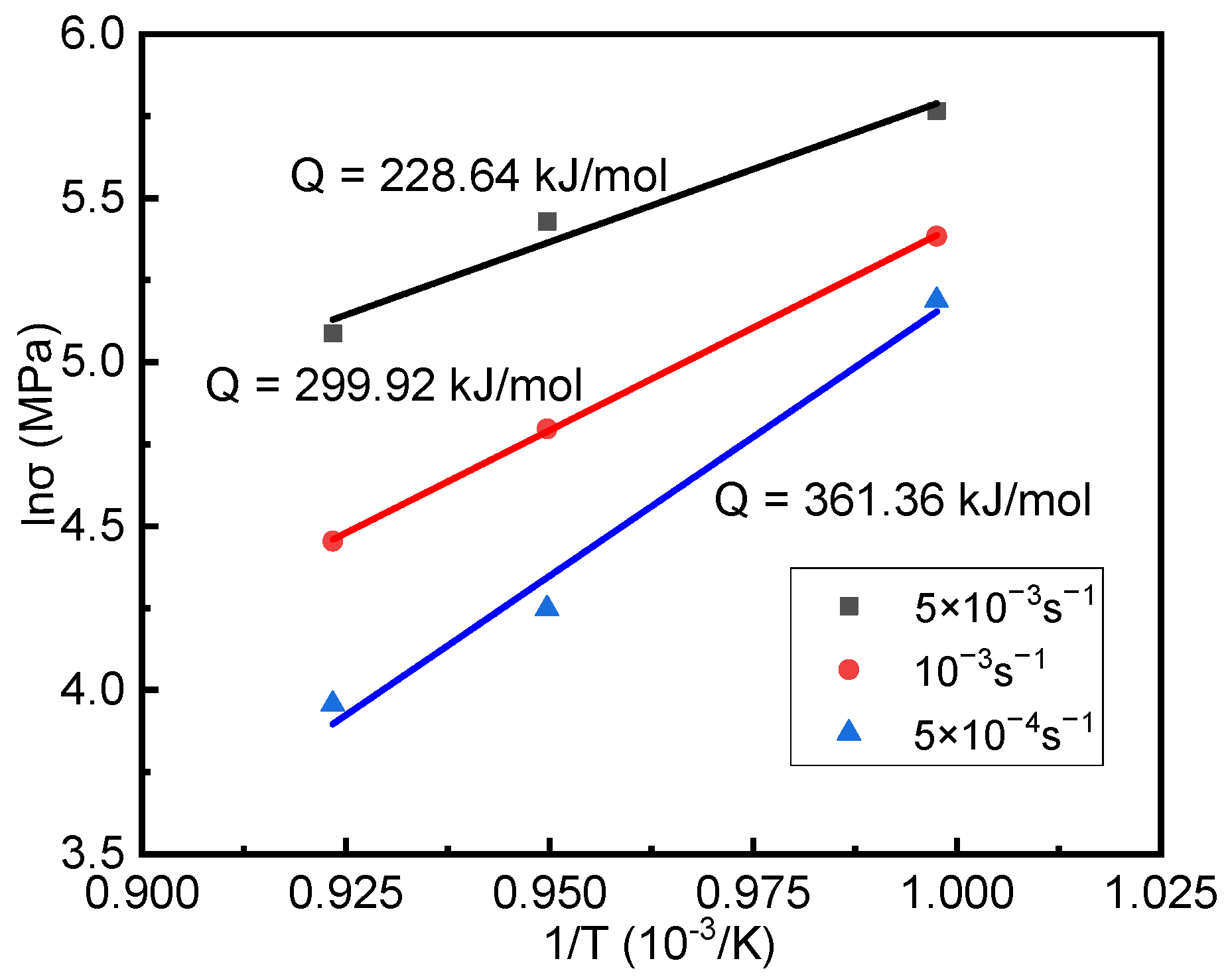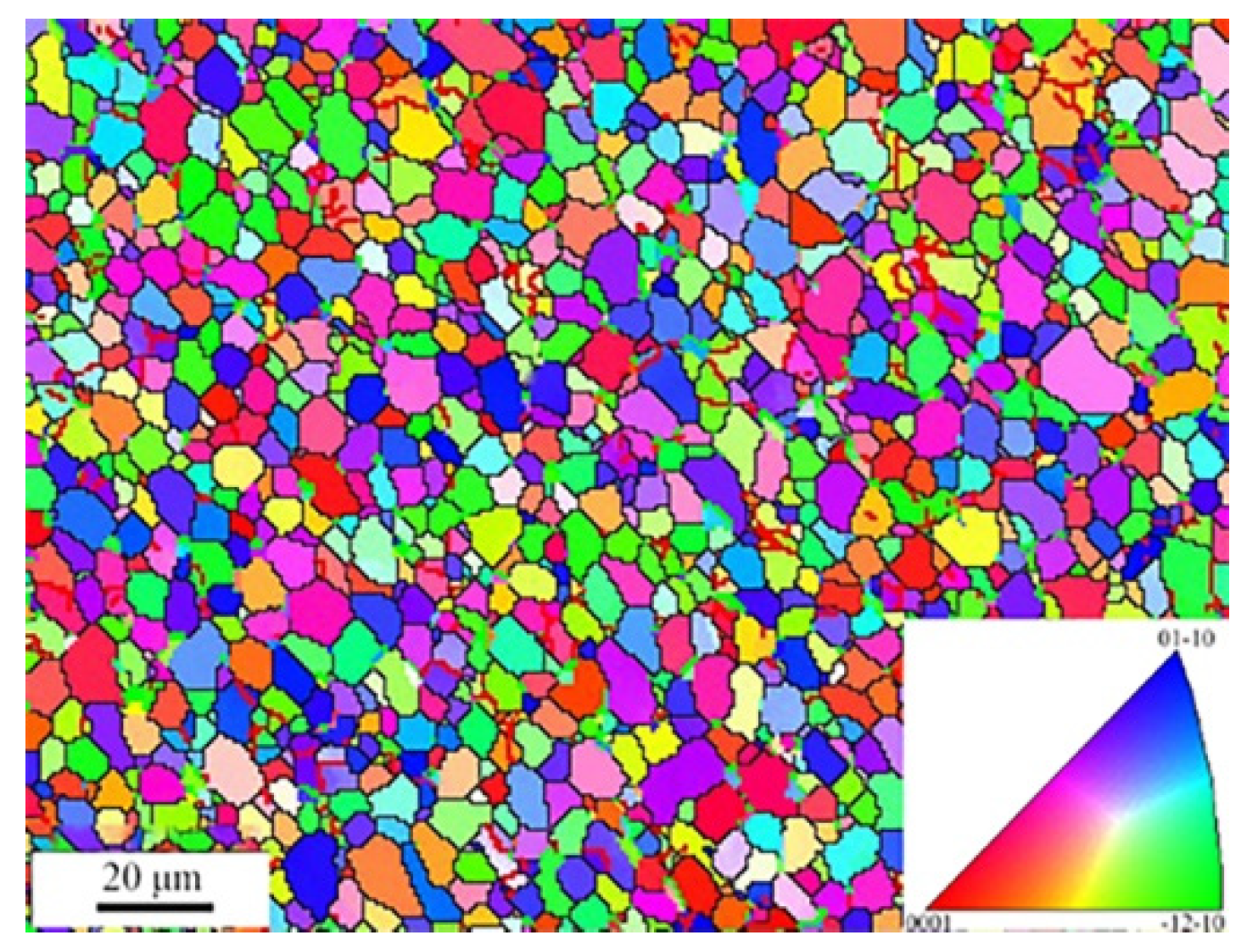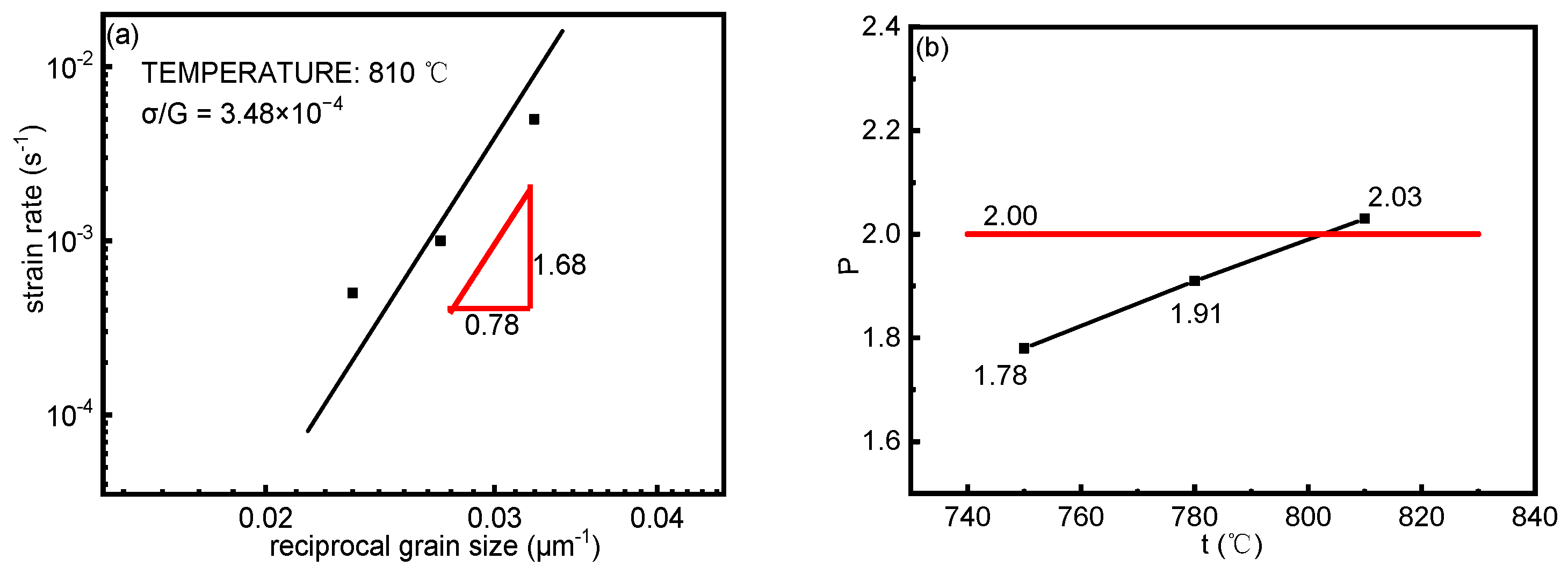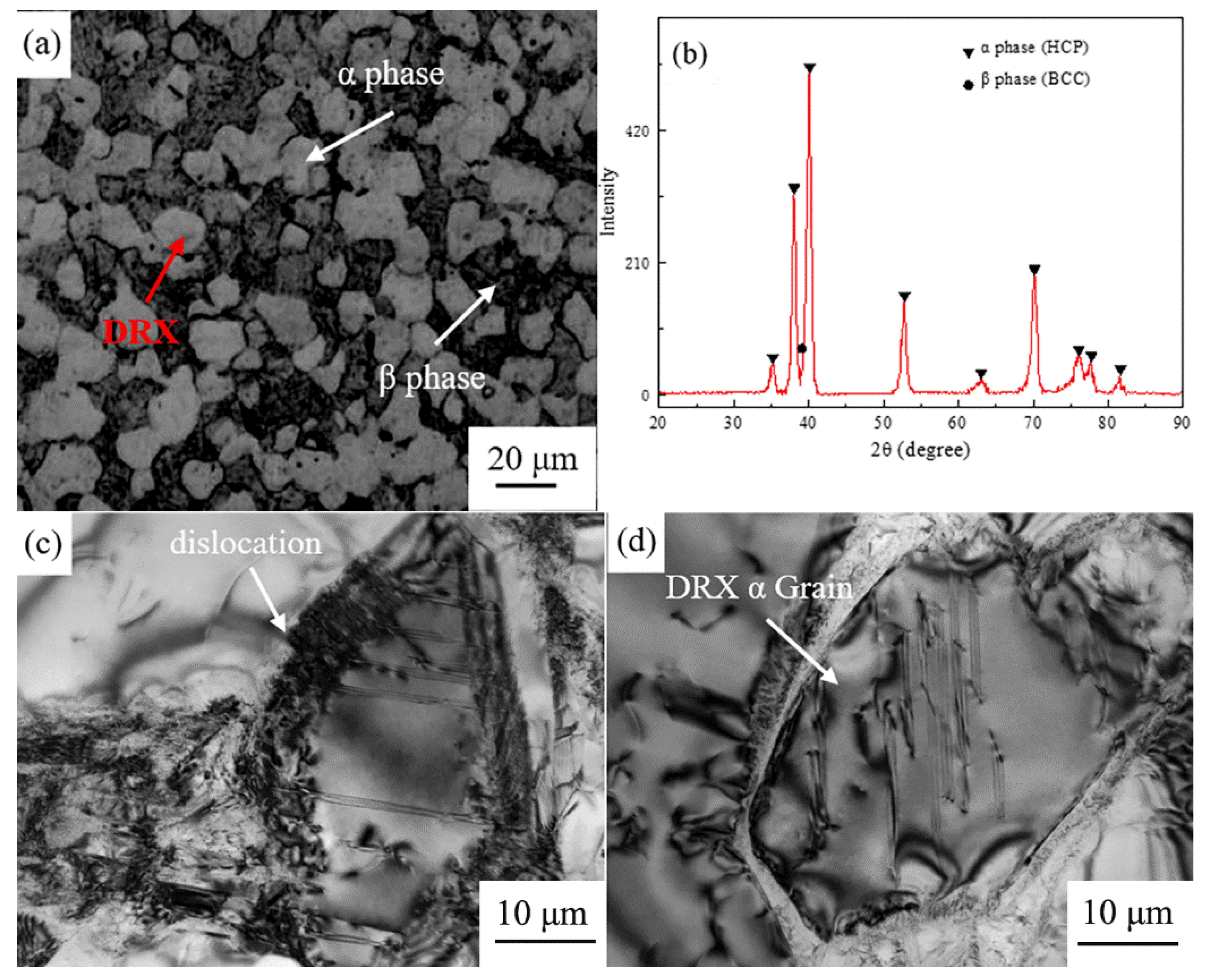Superplastic Deformation Behaviors and Power Dissipation Rate for Fine-Grained Ti-6Al-4V Titanium Alloy Processed by Direct Rolling
Abstract
:1. Introduction
2. Experimental Procedures
2.1. Material and Its Preparation
2.2. Tensile Testing
2.3. Characterization of Microstructures
3. Results and Discussion
3.1. Superplastic Flow Behaviors
3.2. Microstructural Evolution
3.3. Energy Dissipation during Superplastic Deformation of Ti-6Al-4V
4. Conclusions
- The superplastic deformation to failure of the rolled Ti-6Al-4V alloy plates maximized to 816% at 810 °C and 5 × 10−4 s−1, and at this moment, m was 0.53, Q value was 316.36 kJ/mol, and p was 2;
- The α(2.1 V)-phase and β(16.2 V)-phase Gibbs free energy of Ti-6Al-4V at 810 °C was 665.759 and −5857.162 J/mol, respectively, which thermodynamically confirmed that the β phase played an important regulating role in the superplastic deformation;
- A power dissipation rate model of Ti-6Al-4V during the superplastic deformation was built and used to predict the changing laws of energy in the dynamic recrystallization and grain boundary sliding during superplastic deformation.
Author Contributions
Funding
Data Availability Statement
Conflicts of Interest
References
- Vanderhasten, M.; Rabet, L.; Verlinden, B. Deformation Mechanisms of Ti-6Al-4V During Tensile Behavior at Low Strain Rate. J. Mater. Eng. Perform. 2007, 16, 208–212. [Google Scholar] [CrossRef]
- Meng, B.; Fu, M.W.; Shi, S.Q. Deformation behavior and microstructure evolution in thermal-aided mesoforming of titanium dental abutment. Mater. Des. 2016, 89, 1283–1293. [Google Scholar] [CrossRef]
- Li, X.; Guo, G.; Xiao, J.; Song, N.; Li, D. Constitutive modeling and the effects of strain-rate and temperature on the formability of Ti–6Al–4V alloy sheet. Mater. Des. 2014, 55, 325–334. [Google Scholar] [CrossRef]
- Shahmir, H.; Naghdi, F.; Pereira, P.; Huang, Y.; Langdon, T. Factors influencing superplasticity in the Ti-6Al-4V alloy processed by high-pressure torsion. Mater. Sci. Eng. A 2018, 718, 198–206. [Google Scholar] [CrossRef] [Green Version]
- Zhang, W.; Ding, H.; Pereira, P.; Huang, Y.; Langdon, T. Grain refinement and superplastic flow in a fully lamellar Ti-6Al-4V alloy processed by high-pressure torsion. Mater. Sci. Eng. A 2018, 732, 398–405. [Google Scholar] [CrossRef] [Green Version]
- Wu, L.H.; Jia, C.L.; Han, S.C.; Li, N.; Ni, D.R.; Xiao, B.L.; Ma, Z.Y.; Fu, M.J.; Wang, Y.Q.; Zeng, Y.S. Superplastic deformation behavior of lamellar microstructure in a hydrogenated friction stir welded Ti-6Al-4V joint. J. Alloy. Compd. 2019, 787, 1320–1326. [Google Scholar] [CrossRef]
- Mosleh, A.O.; Mikhaylovskaya, A.V.; Kotov, A.D.; Kwame, J.S. Experimental, modelling and simulation of an approach for optimizing the superplastic forming of Ti-6%Al-4%V titanium alloy. J. Manuf. Process. 2019, 45, 262–272. [Google Scholar] [CrossRef]
- Tan, Z.; Bai, L.; Bai, B.; Zhao, B.; Li, Z.; Hou, H. Fabrication of lattice truss structures by novel super-plastic forming and diffusion bonding process in a titanium alloy. Mater. Des. 2016, 92, 724–730. [Google Scholar] [CrossRef]
- Li, K.; Fu, X.S.; Chen, G.Q.; Li, Z.Q. Mechanical properties of strengthened surface layer in Ti–6Al–4V alloy induced by wet peening treatment. Trans. Nonferrous Met. Soc. 2016, 26, 2868–2873. [Google Scholar] [CrossRef]
- Li, Z.Q.; Han, K.; Hou, H.L.; Wang, B.Y.; Hu, Z.H. Effect of Hydrogen on Diffusion Bonding Behavior and Mechanism of Ti-6Al-4V alloy. Rare Met. Mat. Eng. 2014, 43, 306–310. [Google Scholar]
- Chen, G.Q.; Yan, J.; Tian, T.Y.; Zhang, X.H.; Li, Z.Q.; Zhou, W.L. Effect of wet shot peening on Ti-6Al-4V alloy treated by ceramic beads. Trans. Nonferrous Met. Soc. 2014, 24, 690–696. [Google Scholar] [CrossRef]
- Kishchik, A.A.; Kotov, A.D.; Mikhaylovskaya, A.V. The Microstructure and High-Strain-Rate Superplasticity of the Al–Mg–Ni–Fe–Mn–Cr–Zr Alloy. Phys. Met. Metallogr. 2019, 120, 1006–1013. [Google Scholar] [CrossRef]
- Shaomin, L.; Chonglin, J.; Xinbo, H.; Zhipeng, W.; Xinxu, L.; Xuanhui, Q. Superplastic Deformation and Dynamic Recrystallization of a Novel Disc Superalloy GH4151. Materials 2019, 12, 3667. [Google Scholar]
- Tan, L.; Li, Y.; Liu, F.; Nie, Y.; Jiang, L. Superplastic behavior of a powder metallurgy superalloy during isothermal compression. J. Mater. Sci. Technol. 2019, 35, 2591–2599. [Google Scholar] [CrossRef]
- Eleti, R.R.; Bhattacharjee, T.; Shibata, A.; Tsuji, N. Unique deformation behavior and microstructure evolution in high temperature processing of HfNbTaTiZr refractory high entropy alloy. Acta Mater. 2019, 171, 132–145. [Google Scholar] [CrossRef]
- Ghosh, A.K.; Hamilton, C.H. Influences of material parameters and microstructure on superplastic forming. Met. Trans. A 1982, 13, 733–743. [Google Scholar] [CrossRef]
- Park, C.H.; Ko, Y.G.; Park, J.W.; Lee, C.S. Enhanced superplasticity utilizing dynamic globularization of Ti–6Al–4V alloy. Mater. Sci. Eng. A 2008, 496, 150–158. [Google Scholar] [CrossRef]
- Kawasaki, M.; Langdon, G. Developing superplasticity and a deformation mechanism map for the Zn–Al eutectoid alloy processed by high-pressure torsion. Mater. Sci. Eng. A 2011, 528, 6140–6145. [Google Scholar] [CrossRef]
- Umemoto, M.; Hiramatsu, A.; Moriya, A. Computer modelling of phase transformation from work-hardened austenite. ISIJ Int. 1992, 32, 306–315. [Google Scholar] [CrossRef] [Green Version]
- Perez, P.A.; Dyment, F.; Abriola, D.; Bermudez, G.G.; Somacal, H. Determination of diffusion rates in α-Ti by Heavy Ion Rutherford Backscattering. J. Nucl. Mater. 1992, 186, 206–208. [Google Scholar] [CrossRef]
- Reca, N.E.; Libanati, C.M. Autodifusion de titanio beta y hafnio beta Self-diffusion in β-titanium and β-hafniumAutodiffusion du titane beta et de l’hafnium betaSelbstdiffusion in β-titan und β-hafnium. Acta Metall. 1968, 16, 1297–1305. [Google Scholar]
- Schwaighofer, E.; Clemens, H.; Lindemann, J.; Stark, A.; Mayer, S. Hot-working behavior of an advanced intermetallic multi-phase γ-TiAl based alloy. Mater. Sci. Eng. A 2014, 614, 297–310. [Google Scholar] [CrossRef] [Green Version]
- Cui, N.; Kong, F.T.; Wang, X.P.; Chen, Y.; Zhou, H. Hot deformation behavior and dynamic recrystallization of a β-solidifying TiAl alloy. Mater. Sci. Eng. A 2016, 652, 231–238. [Google Scholar] [CrossRef]
- Chiba, A.; Lee, S.H.; Matsumoto, H.; Nakamura, M. Construction of processing map for biomedical Co–28Cr–6Mo–0.16 N alloy by studying its hot deformation behavior using compression tests. Mater. Sci. Eng. A 2009, 513, 286–293. [Google Scholar] [CrossRef]








| Temperature T, °C | Initial Strain Rate , s−1 | Strain Rate Sensitivity Exponent m | Deformation to Failure δ, % |
|---|---|---|---|
| 750 | 5 × 10−3 | 0.41 | 301 |
| 750 | 10−3 | 0.42 | 327 |
| 750 | 5 × 10−4 | 0.44 | 390 |
| 780 | 5 × 10−3 | 0.43 | 367 |
| 780 | 10−3 | 0.46 | 448 |
| 780 | 5 × 10−4 | 0.47 | 500 |
| 810 | 5 × 10−3 | 0.46 | 434 |
| 810 | 10−3 | 0.51 | 692 |
| 810 | 5 × 10−4 | 0.53 | 816 |
| Phase | x(αTi) | x(βTi) | |||
|---|---|---|---|---|---|
| α(2.1 V) | 0.92 | 0.08 | −49.577 | 2.317 | 665.759 |
| β(16.2 V) | 0.56 | 0.44 | −2077.512 | 5.693 | −5857.162 |
Publisher’s Note: MDPI stays neutral with regard to jurisdictional claims in published maps and institutional affiliations. |
© 2022 by the authors. Licensee MDPI, Basel, Switzerland. This article is an open access article distributed under the terms and conditions of the Creative Commons Attribution (CC BY) license (https://creativecommons.org/licenses/by/4.0/).
Share and Cite
Wang, X.; Zhou, G.; Men, Y.; Zhang, S.; Zhang, H.; Li, F.; Chen, L. Superplastic Deformation Behaviors and Power Dissipation Rate for Fine-Grained Ti-6Al-4V Titanium Alloy Processed by Direct Rolling. Crystals 2022, 12, 270. https://doi.org/10.3390/cryst12020270
Wang X, Zhou G, Men Y, Zhang S, Zhang H, Li F, Chen L. Superplastic Deformation Behaviors and Power Dissipation Rate for Fine-Grained Ti-6Al-4V Titanium Alloy Processed by Direct Rolling. Crystals. 2022; 12(2):270. https://doi.org/10.3390/cryst12020270
Chicago/Turabian StyleWang, Xin, Ge Zhou, Yue Men, Siqian Zhang, Haoyu Zhang, Feng Li, and Lijia Chen. 2022. "Superplastic Deformation Behaviors and Power Dissipation Rate for Fine-Grained Ti-6Al-4V Titanium Alloy Processed by Direct Rolling" Crystals 12, no. 2: 270. https://doi.org/10.3390/cryst12020270
APA StyleWang, X., Zhou, G., Men, Y., Zhang, S., Zhang, H., Li, F., & Chen, L. (2022). Superplastic Deformation Behaviors and Power Dissipation Rate for Fine-Grained Ti-6Al-4V Titanium Alloy Processed by Direct Rolling. Crystals, 12(2), 270. https://doi.org/10.3390/cryst12020270







